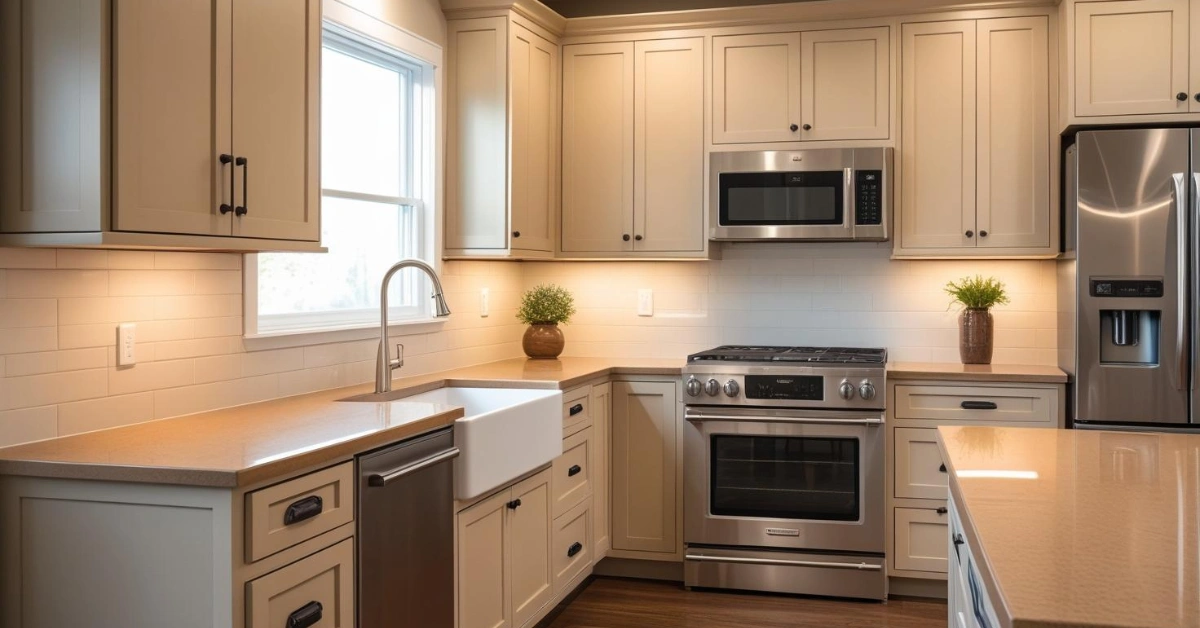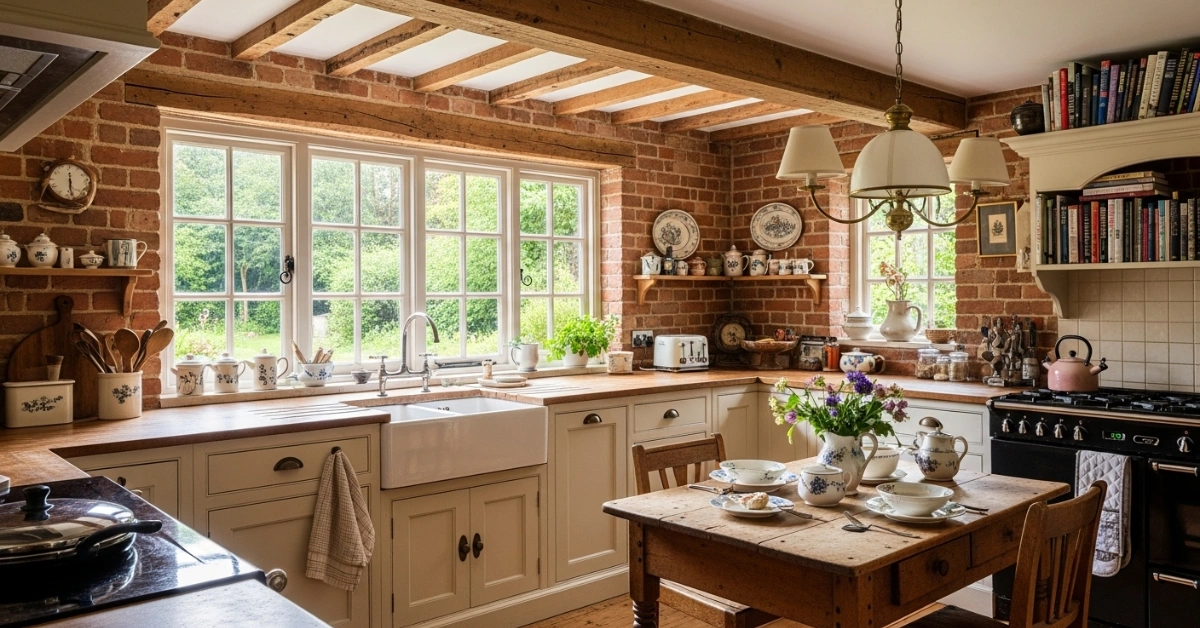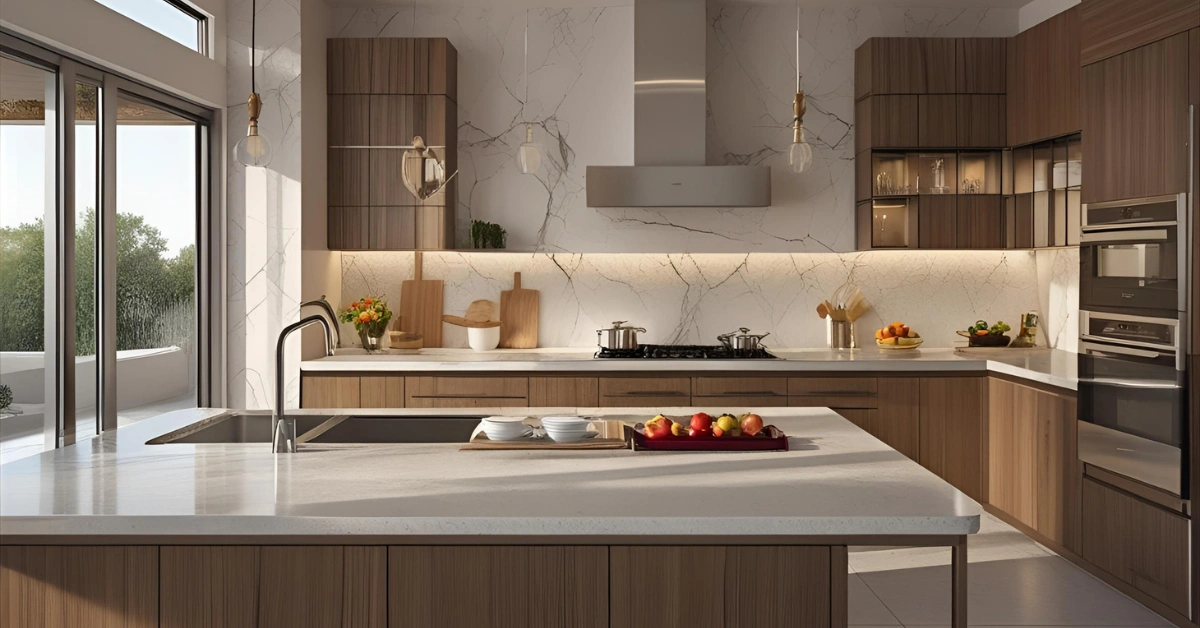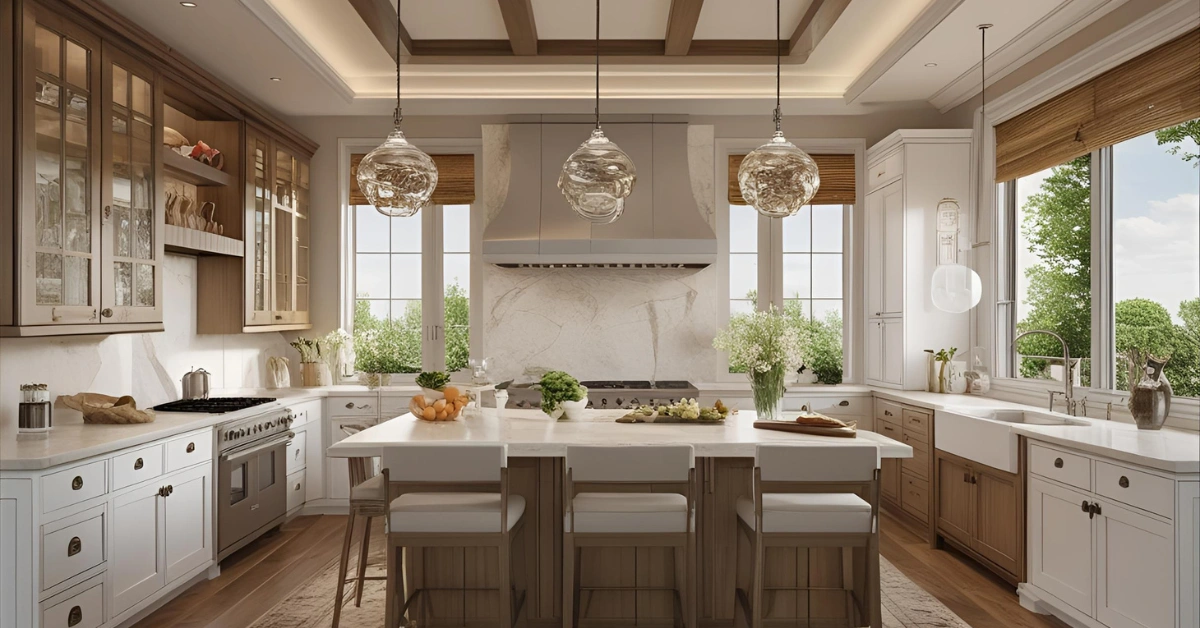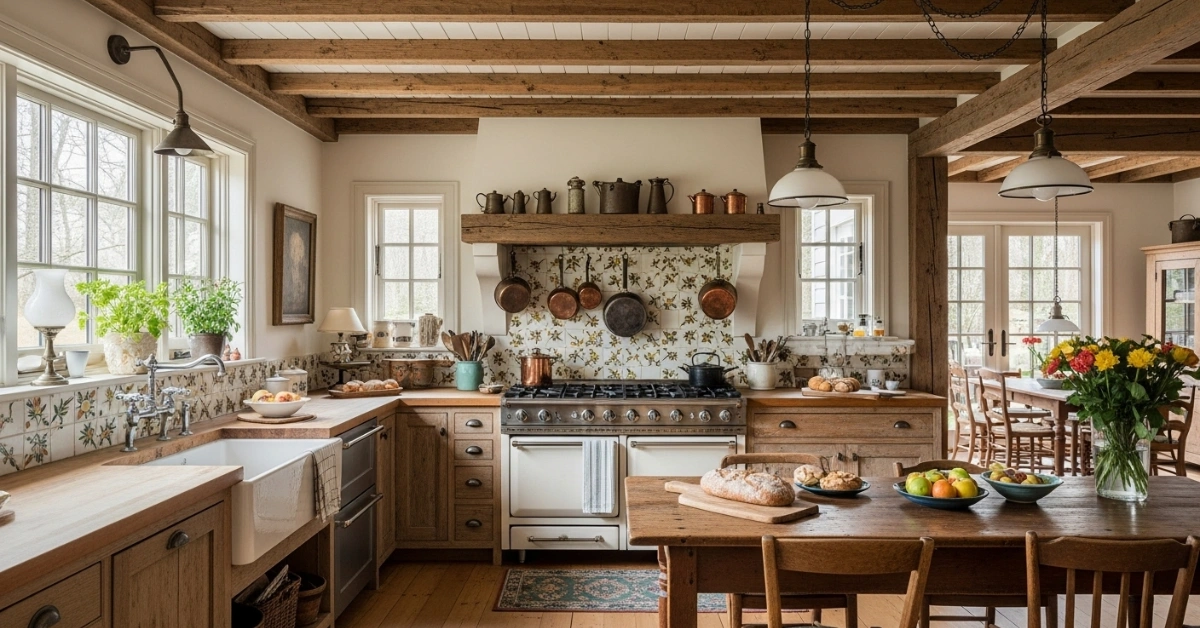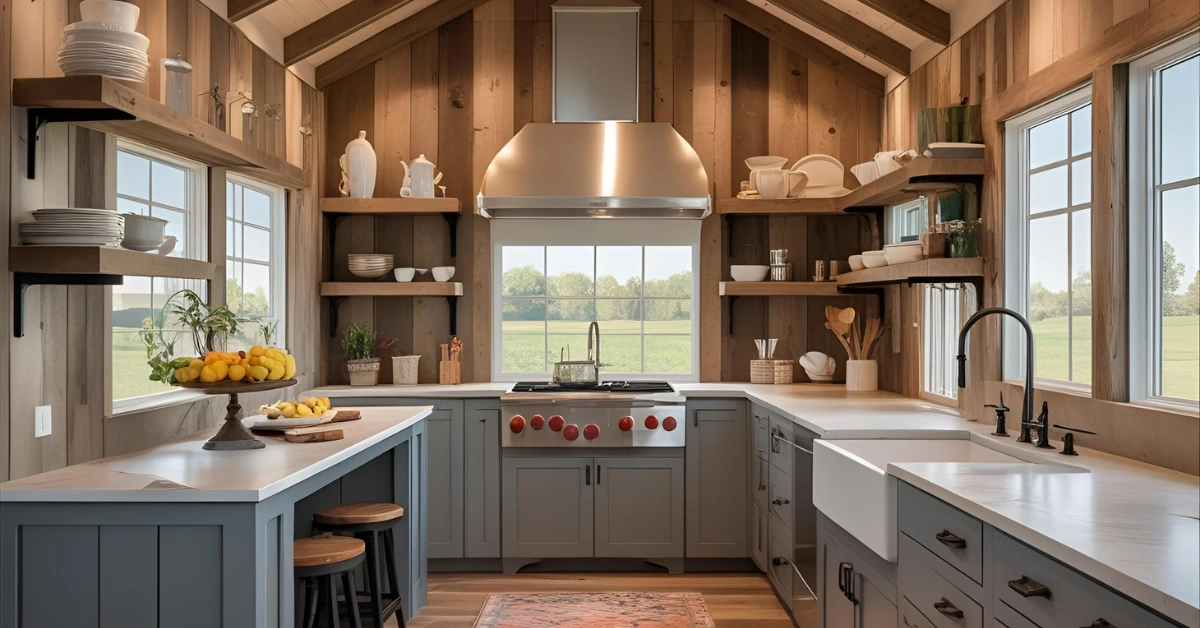Industrial Kitchen Design: 13+ Bold & Functional Ideas
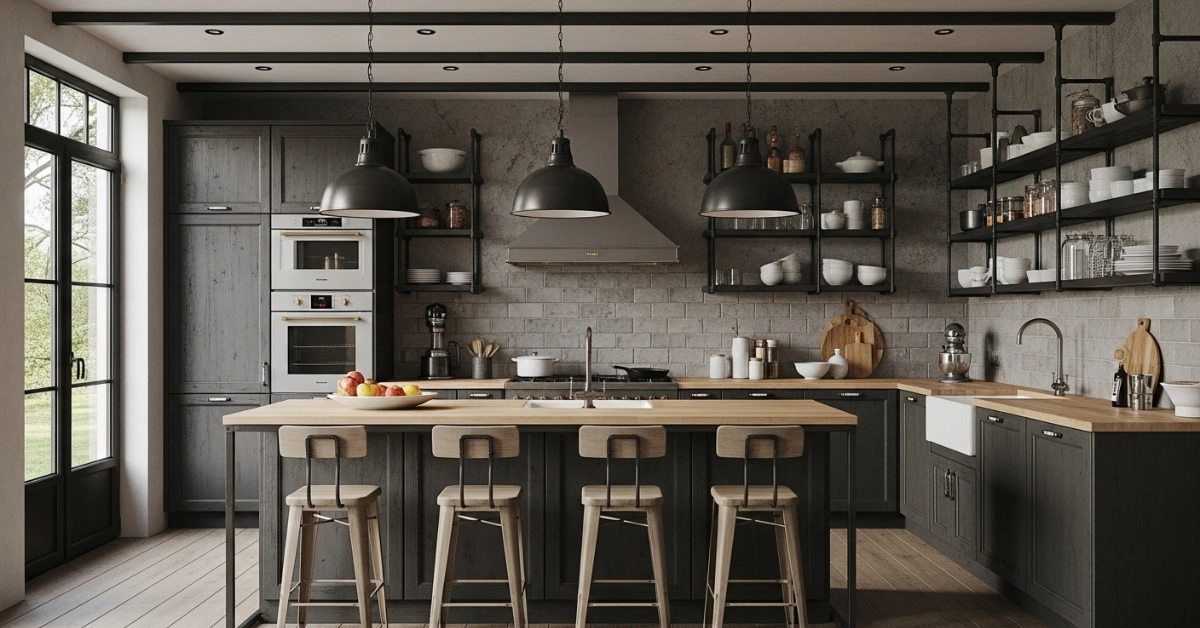
Kitchens are the heart of any home, but designing one that balances aesthetics, functionality, and durability can feel overwhelming. Many homeowners struggle to create a space that reflects their personality while meeting practical needs like ample storage, easy maintenance, and efficient workflows. Industrial kitchen design offers a perfect solution, combining raw, rugged elements with sleek, modern touches to craft a space that’s both visually striking and highly functional. In this comprehensive guide, we’ll explore the core principles of industrial kitchen design, share inspiring ideas, and provide actionable tips to help you transform your kitchen into a bold, timeless masterpiece.
Whether you’re renovating a small apartment kitchen or designing a spacious culinary hub, industrial design adapts to any space. With its emphasis on exposed materials, neutral tones, and practical layouts, this style delivers a unique blend of character and utility. Let’s dive into the key elements, design tips, and real-world examples to bring this trend to life in your home.
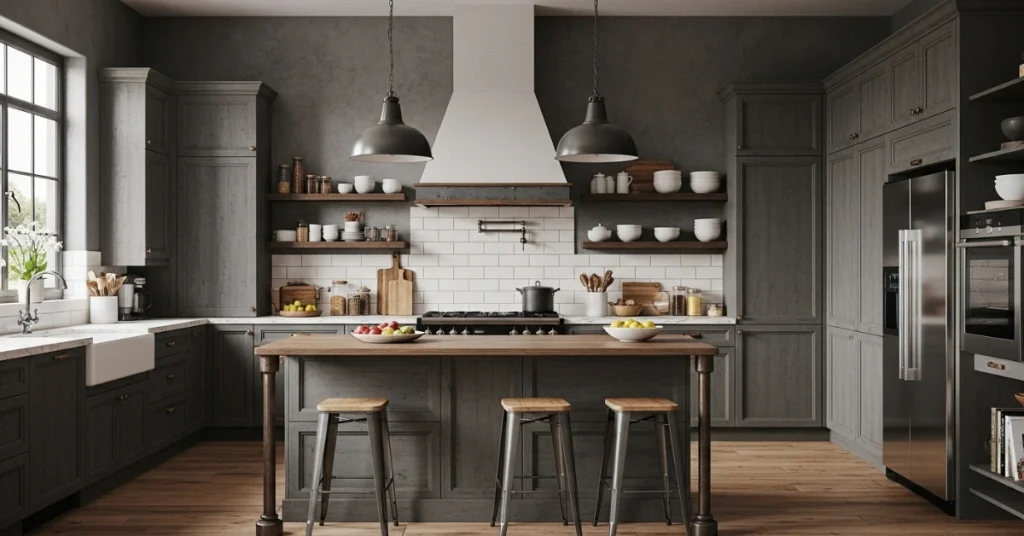
What is Industrial Kitchen Design?
Industrial kitchen design draws inspiration from old factories, warehouses, and urban lofts. Popularized in the early 2000s, this style emerged as people began converting industrial spaces into homes, embracing raw materials like exposed brick, concrete, and metal. According to a 2023 report by the National Kitchen and Bath Association, industrial design remains a top trend, with 18% of homeowners opting for its rugged charm in kitchen renovations.
The style emphasizes functionality, durability, and minimalism, often featuring open shelving, stainless steel surfaces, and neutral color palettes. It’s not just about aesthetics industrial kitchens are built to withstand heavy use while maintaining a distinctive, edgy vibe. As designer Sarah Johnson notes, “Industrial kitchen design is about celebrating imperfections raw textures and sturdy materials create a lived-in feel that’s both practical and inviting.”
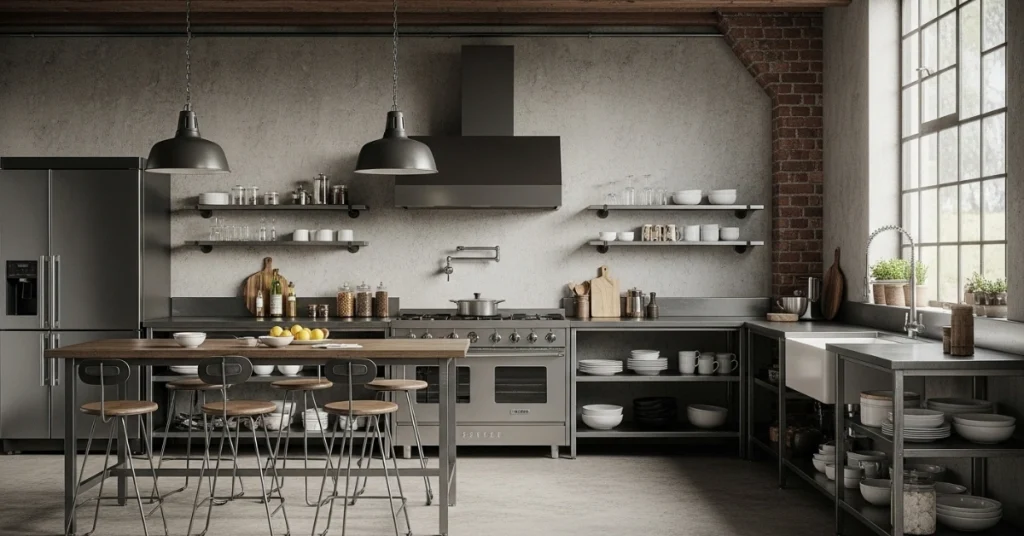
Key Characteristics of Industrial Kitchen Design
- Raw Materials: Exposed brick, concrete, reclaimed wood, and metals like steel or iron.
- Neutral Palette: Grays, blacks, whites, and earthy tones dominate, with occasional pops of color.
- Functional Elements: Open shelving, large workstations, and durable surfaces prioritize utility.
- Minimalist Aesthetic: Clean lines and uncluttered spaces keep the focus on materials and textures.
- Vintage Touches: Edison bulbs, retro appliances, or salvaged decor add character.
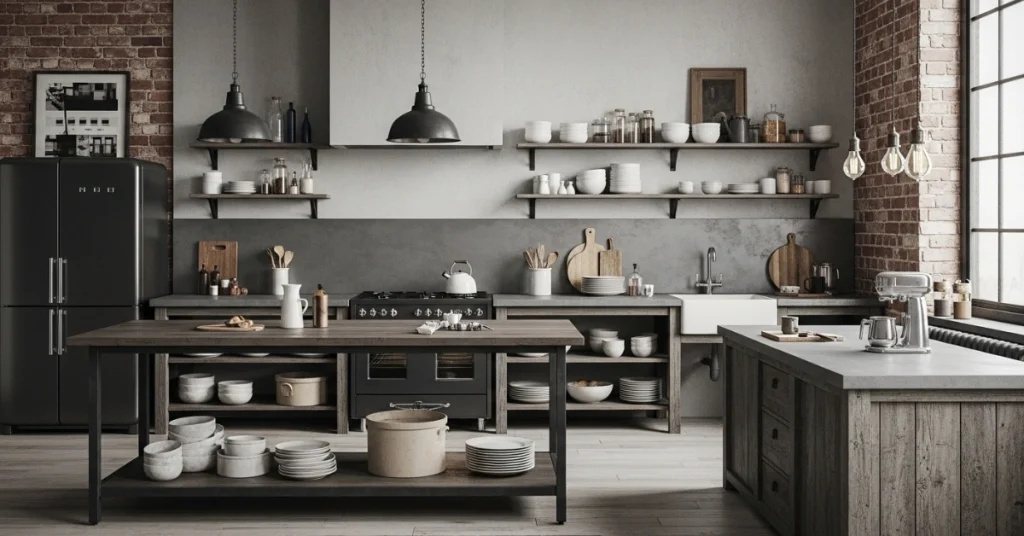
Why Choose Industrial Kitchen Design?
Industrial kitchen design appeals to homeowners who value durability, low maintenance, and a bold aesthetic. Here are some reasons why this style stands out:
- Timeless Appeal: Unlike trendy designs that fade, industrial elements remain relevant due to their classic materials and neutral tones.
- Durability: Materials like stainless steel and concrete are built to last, making them ideal for busy kitchens.
- Versatility: The style works in small apartments, large homes, or even commercial spaces.
- Low Maintenance: Exposed surfaces and sturdy materials are easy to clean and maintain.
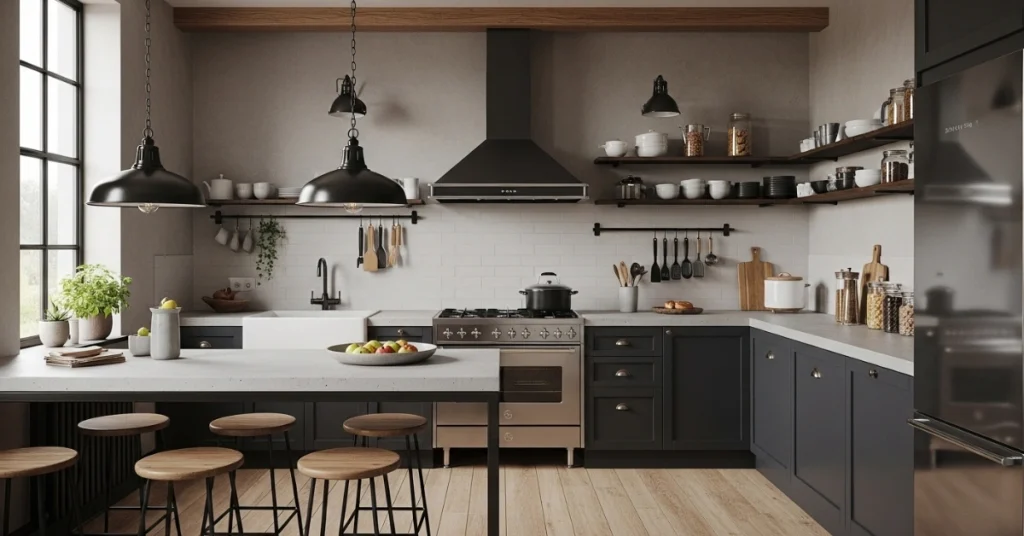
For example, in a recent project I observed, a couple transformed their cramped city apartment kitchen into an industrial-inspired space. By incorporating open metal shelving and a concrete countertop, they maximized storage and created a sleek, open feel without sacrificing functionality.
Core Elements of Industrial Kitchen Design
To create an authentic industrial kitchen, focus on these essential components. Each element contributes to the overall aesthetic while ensuring the space remains practical.
1. Raw and Exposed Materials
The hallmark of industrial kitchen design is its use of raw, unfinished materials. Exposed brick walls, concrete floors, or weathered wood beams add texture and character. These materials don’t just look good they’re incredibly durable. For instance, concrete countertops resist scratches and heat, making them ideal for heavy-duty cooking.
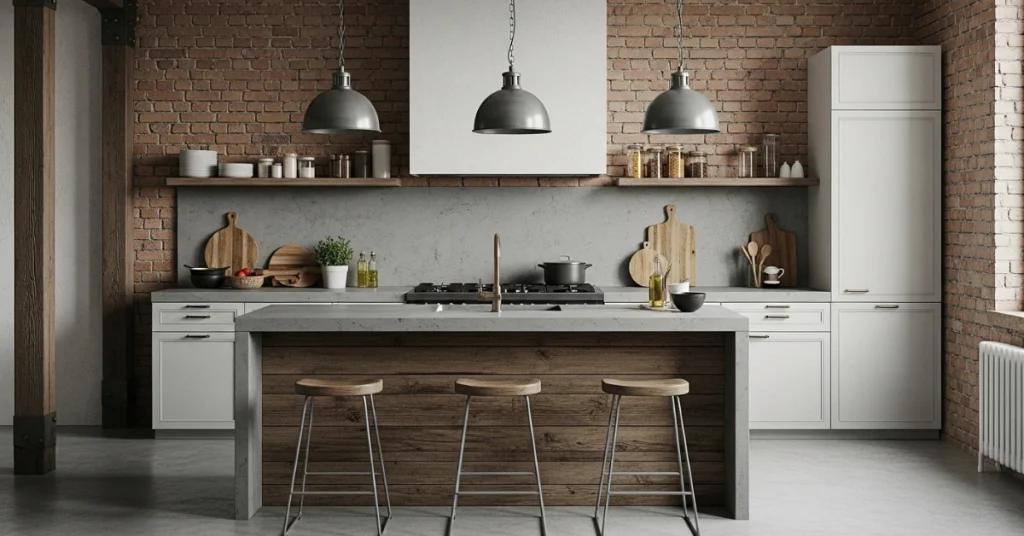
Tips for Incorporating Raw Materials:
- Use reclaimed wood for open shelves or a kitchen island.
- Install a brick or faux-brick backsplash for a rustic touch.
- Opt for polished concrete floors for a sleek, low-maintenance surface.
Designer Tip: “Mix textures to avoid a cold, sterile look. Pair concrete with warm wood or soft textiles,” advises interior designer Michael Lee.
2. Stainless Steel Accents
Stainless steel is a staple in industrial kitchens, offering both durability and a professional-grade aesthetic. From countertops to appliances, this material reflects light and adds a modern edge.
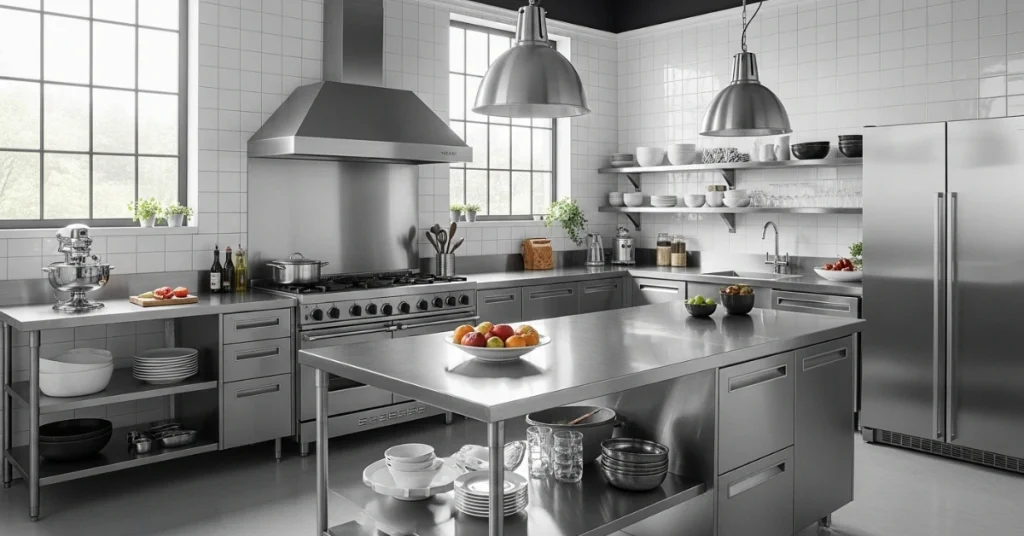
Ways to Use Stainless Steel:
- Choose stainless steel appliances like refrigerators or ovens for a cohesive look.
- Install a stainless steel backsplash for easy cleaning and a reflective surface.
- Add metal bar stools or cabinet hardware for subtle accents.
3. Open Shelving and Storage
Industrial kitchens prioritize open, accessible storage over traditional cabinetry. Open shelving showcases dishes, cookware, or decor while keeping the space airy and functional.
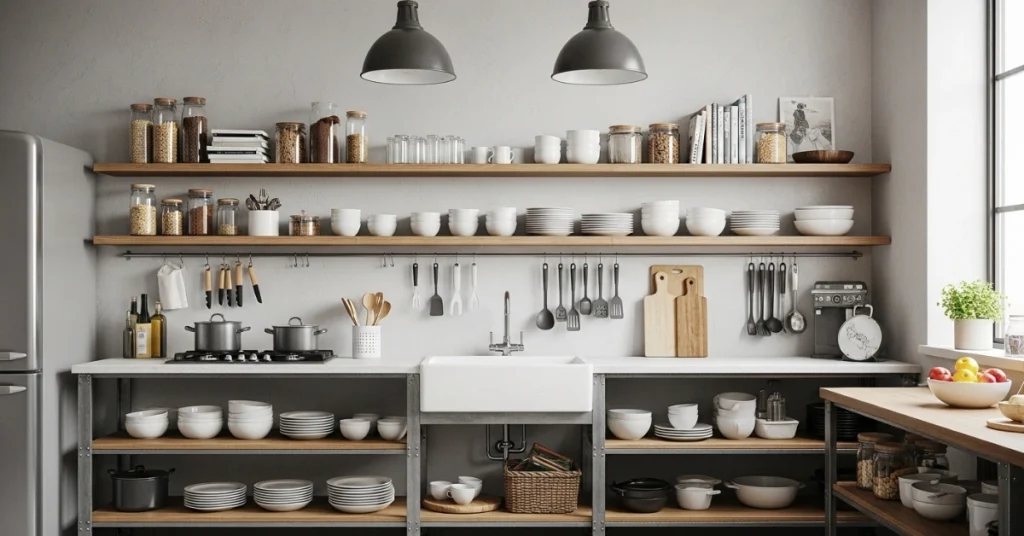
How to Style Open Shelving:
- Use sturdy metal or reclaimed wood shelves.
- Display neutral-colored dishware or vintage kitchen tools for charm.
- Keep shelves organized to avoid a cluttered look.
In a recent home tour, I saw a kitchen where open steel shelves held neatly arranged ceramic bowls and copper pots, creating a perfect balance of function and style.
4. Neutral Color Palette with Bold Accents
Industrial kitchens lean on neutral tones like gray, black, white, and brown. These colors create a cohesive, calming backdrop that highlights textures. For a modern twist, add subtle pops of color through accessories like rugs or pendant lights.
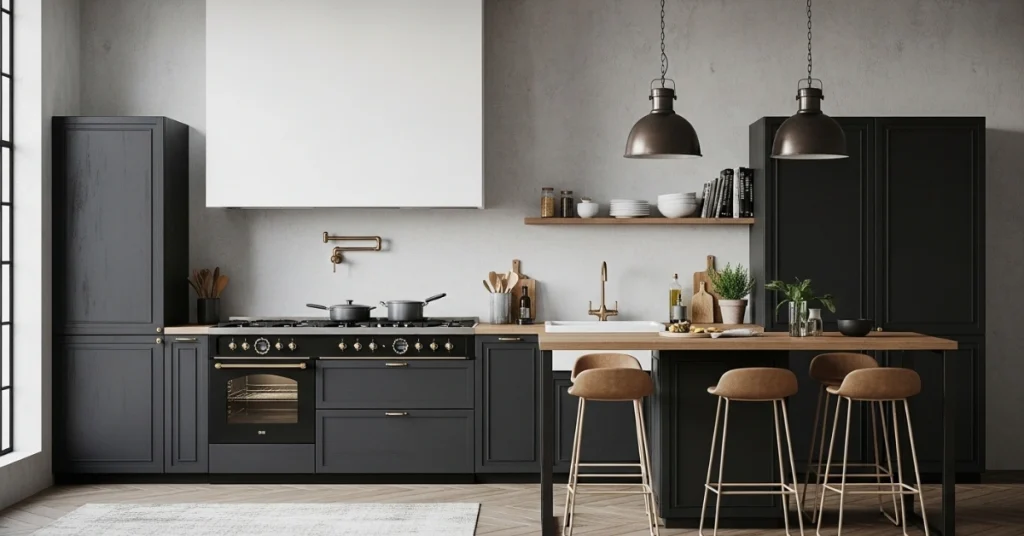
Color Palette Ideas:
- Base Colors: Charcoal gray, matte black, or soft white.
- Accents: Deep navy, mustard yellow, or burnt orange for warmth.
- Metals: Brushed nickel, copper, or blackened steel for hardware.
5. Industrial Lighting
Lighting plays a crucial role in setting the mood. Edison bulbs, pendant lights with exposed filaments, or metal cage fixtures are popular choices. According to Houzz, 65% of industrial kitchen designs feature statement lighting to enhance ambiance.
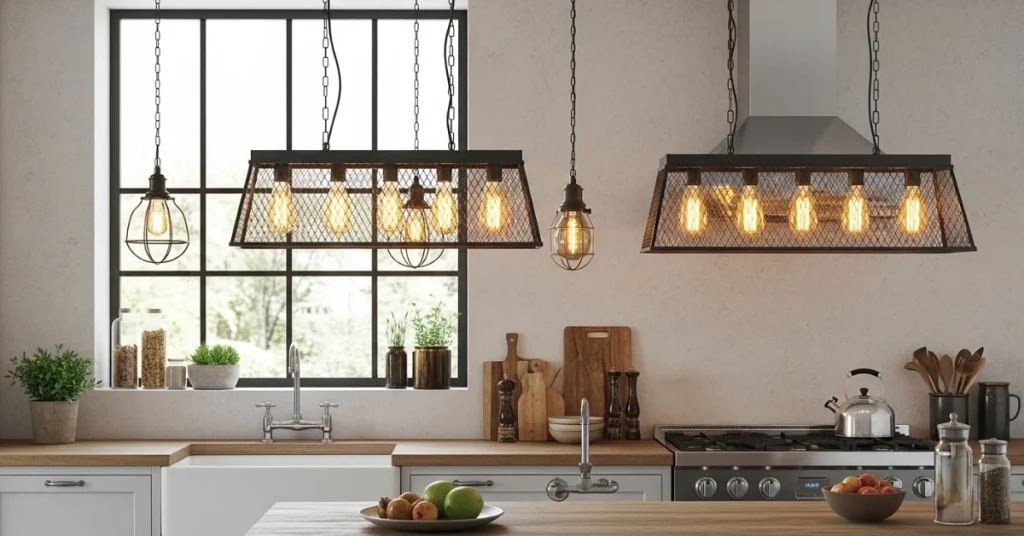
Lighting Tips:
- Hang oversized pendant lights over a kitchen island.
- Use track lighting to highlight work areas.
- Incorporate dimmable bulbs for flexibility in mood and function.
Designing an Industrial Kitchen: Step-by-Step Guide
Ready to bring industrial kitchen design to life? Follow these steps to create a space that’s both stylish and practical.
Step 1: Plan Your Layout
A functional layout is critical in industrial kitchens. Consider the “kitchen triangle” (sink, stove, refrigerator) to ensure efficient workflows. Open-plan designs work well, especially in larger spaces, as they enhance the airy, loft-like feel.
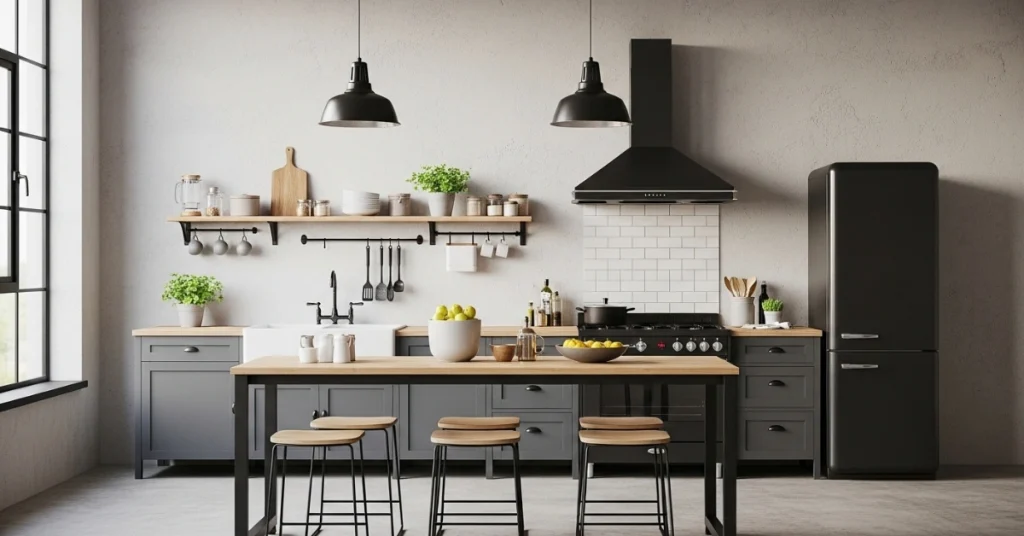
Layout Tips:
- For small kitchens, use a galley or L-shaped layout to maximize space.
- In larger kitchens, incorporate a central island for prep and socializing.
- Ensure ample counter space for cooking and serving.
Step 2: Choose Durable Materials
Select materials that align with the industrial aesthetic while meeting your practical needs. Here’s a quick comparison of popular options:
| Material | Pros | Cons | Best For |
|---|---|---|---|
| Concrete | Durable, heat-resistant, unique | Can stain if not sealed properly | Countertops, floors |
| Stainless Steel | Easy to clean, professional look | Shows fingerprints | Appliances, backsplashes |
| Reclaimed Wood | Warm, rustic, eco-friendly | Requires maintenance | Shelves, islands |
| Exposed Brick | Textured, timeless | Can be hard to clean | Walls, backsplashes |
Step 3: Incorporate Functional Storage
Maximize storage with open shelves, rolling carts, or multi-purpose islands. For example, a kitchen island with built-in shelves can store pots, pans, or even cookbooks while doubling as a casual dining area.
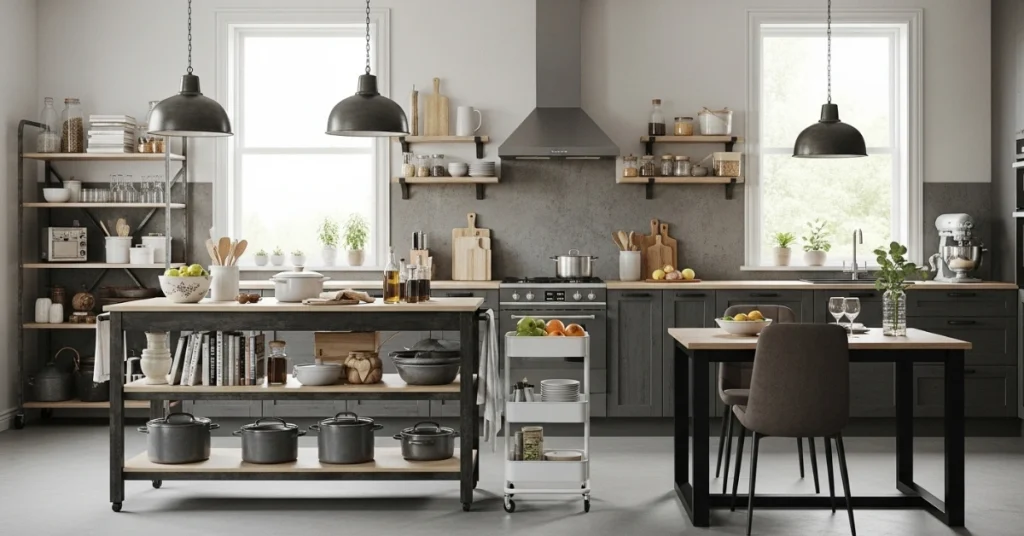
Storage Ideas:
- Install a pot rack to free up cabinet space.
- Use magnetic strips for knives and utensils.
- Add rolling carts for flexible storage in small spaces.
Step 4: Add Personal Touches
While industrial design is minimalist, small details can make the space feel warm and inviting. Vintage signs, potted herbs, or woven rugs add personality without overwhelming the aesthetic.
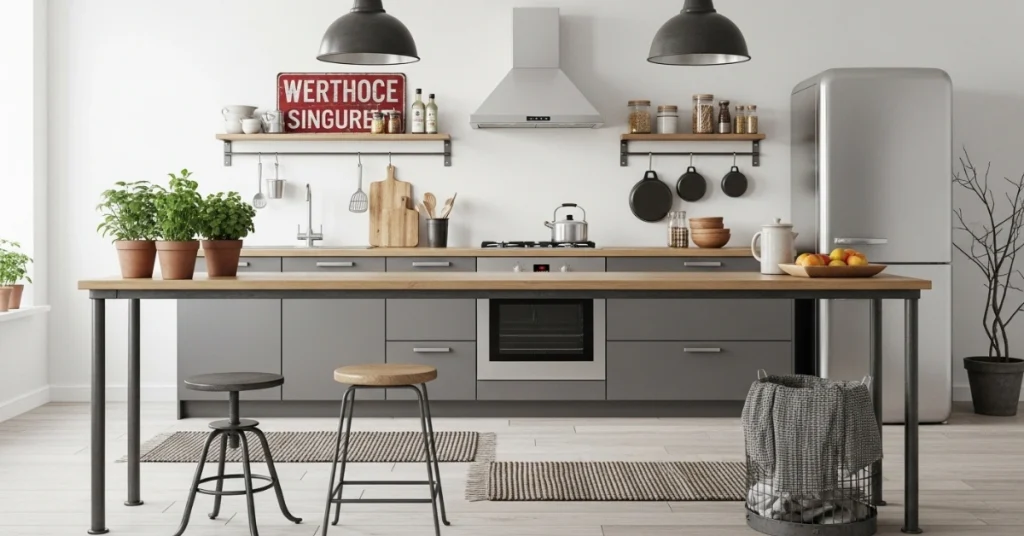
Personalization Tips:
- Display a collection of vintage cookware or glassware.
- Add a chalkboard wall for notes or recipes.
- Incorporate indoor plants for a touch of greenery.
Step 5: Focus on Lighting and Ambiance
Choose lighting that enhances both form and function. Combine task lighting (under-cabinet lights) with ambient lighting (pendant fixtures) to create a welcoming space.
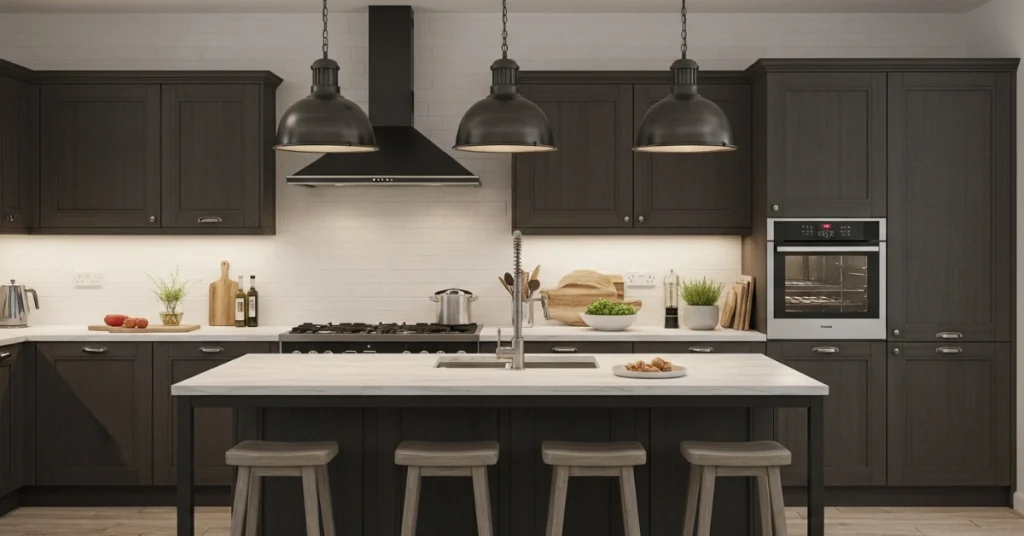
Lighting Combinations:
- Task: LED strip lights under cabinets for prep areas.
- Ambient: Large pendant lights over the island.
- Accent: Wall sconces or Edison bulbs for mood.
Inspiring Industrial Kitchen Design Ideas
Need inspiration? Here are five unique industrial kitchen design ideas to spark your creativity:
Urban Loft Kitchen
Combine exposed brick walls with black metal cabinetry and stainless steel appliances. Add a reclaimed wood island for warmth and texture. This look suits city apartments or open-plan homes.
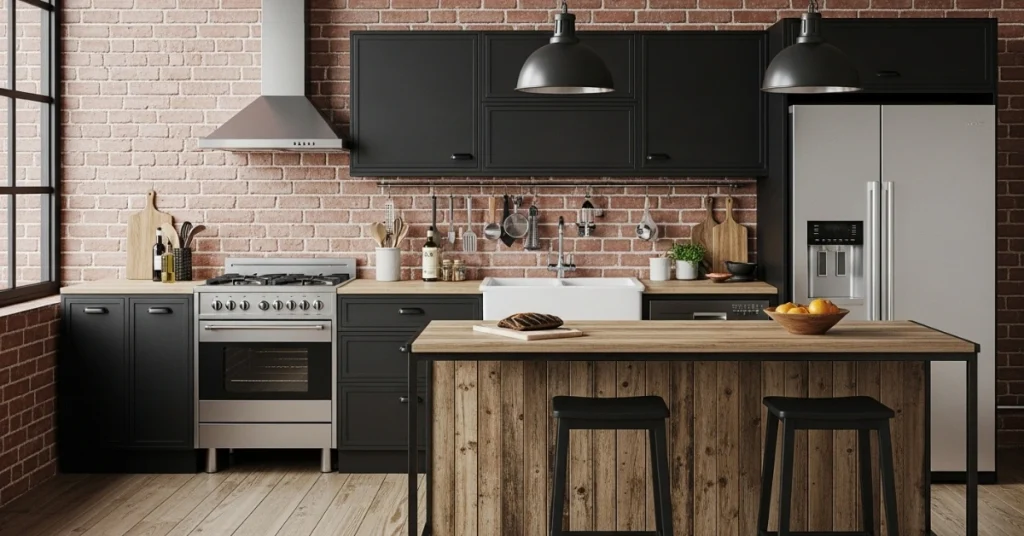
Vintage Industrial
Incorporate retro elements like a distressed leather bar stool or vintage-inspired appliances. Pair with matte black cabinetry and Edison bulb pendants for a nostalgic vibe.
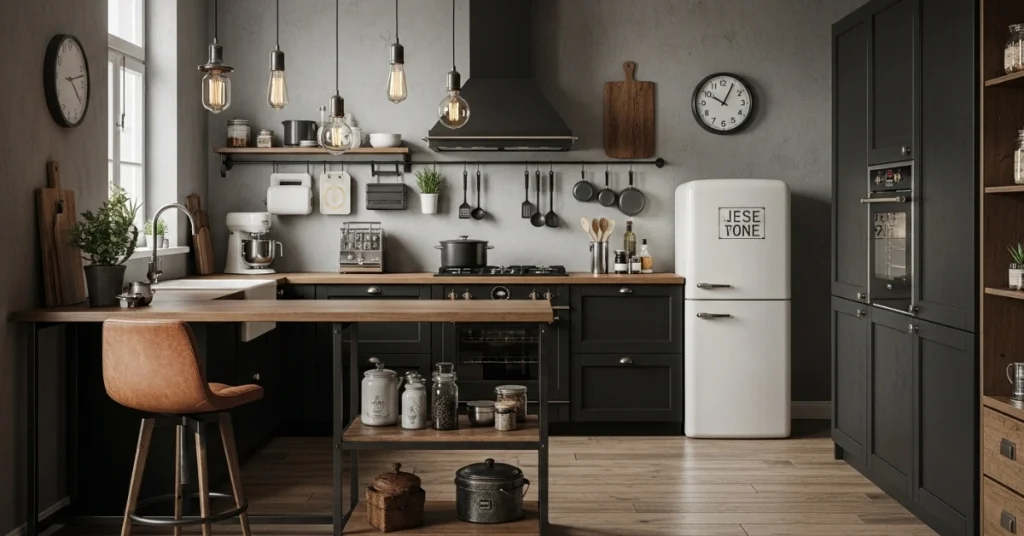
Minimalist Industrial
Keep it sleek with concrete countertops, white subway tiles, and open metal shelving. Use a monochromatic palette with pops of greenery for a modern, clean look.
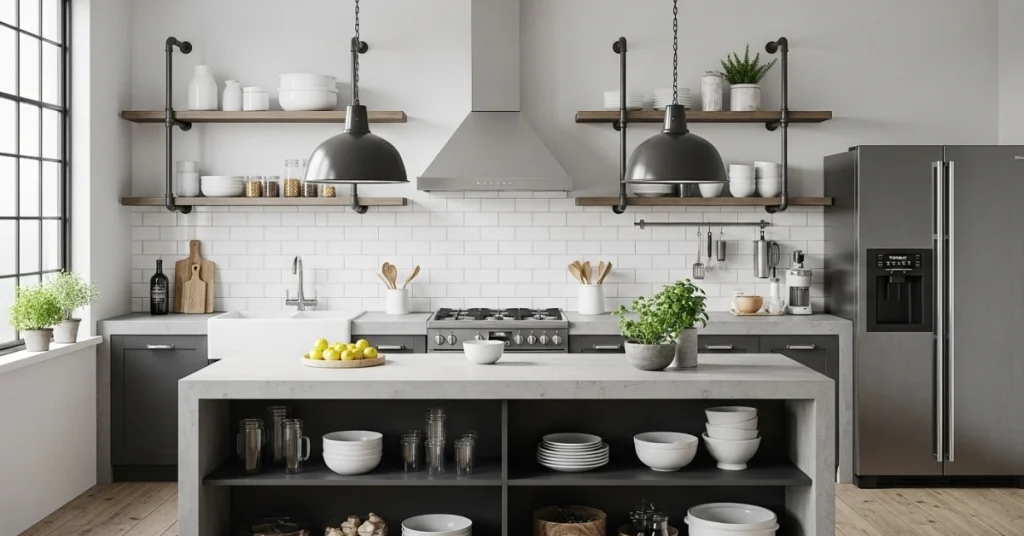
Rustic Industrial
Blend reclaimed wood beams with blackened steel accents. Add a farmhouse sink and woven rugs for a cozy yet rugged feel.
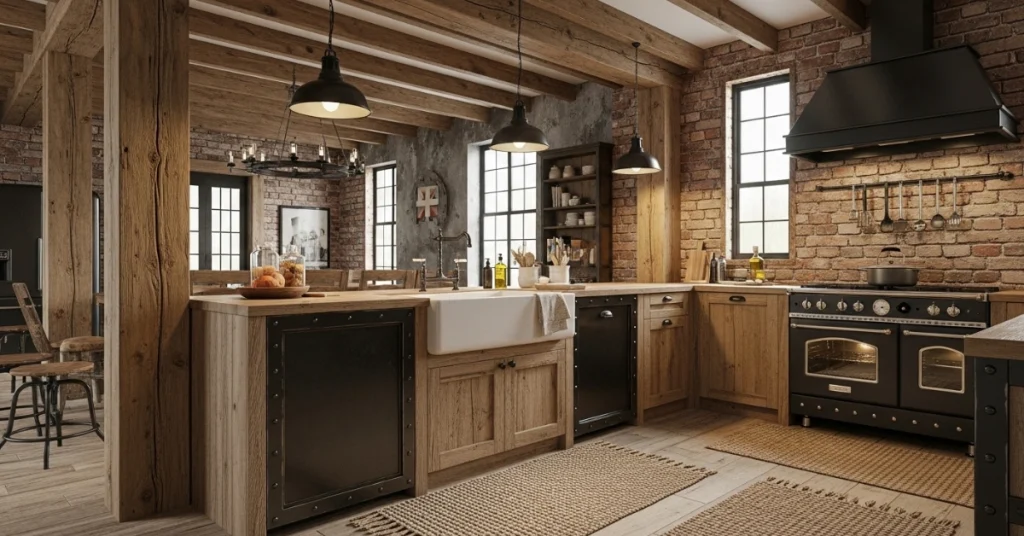
Modern Industrial
Mix sleek stainless steel surfaces with bold color accents, like a navy blue island. Incorporate smart appliances for a high-tech twist on the classic industrial style.
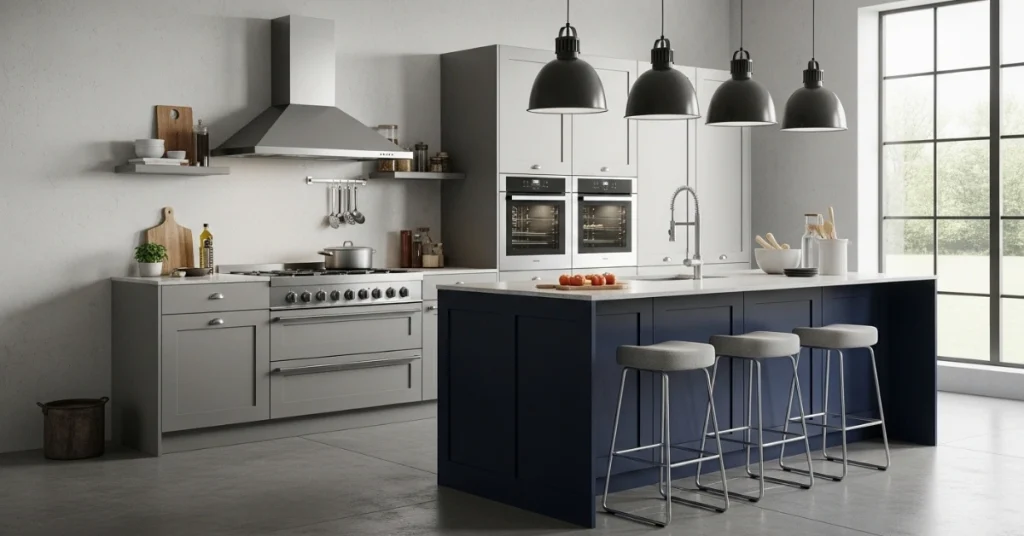
Common Mistakes to Avoid in Industrial Kitchen Design
Even with careful planning, it’s easy to make missteps. Here are common pitfalls and how to avoid them:
- Overloading with Metal: Too much stainless steel or iron can make the space feel cold. Balance with wood or textiles.
- Ignoring Lighting: Poor lighting can make an industrial kitchen feel stark. Use warm-toned bulbs and layered lighting.
- Cluttered Shelving: Open shelves look great but can become messy. Curate items carefully and keep them organized.
- Neglecting Comfort: Industrial design can feel utilitarian. Add soft elements like rugs or cushions for warmth.
Designer Tip: “Don’t let the space feel like a factory. Small touches like plants or colorful dishware make it feel like home,” says designer Emily Carter.
How to Maintain an Industrial Kitchen
Industrial kitchens are low-maintenance, but proper care ensures longevity. Here are some tips:
- Concrete Surfaces: Seal countertops every 1–2 years to prevent stains. Clean with mild soap and water.
- Stainless Steel: Wipe with a microfiber cloth and stainless steel cleaner to remove fingerprints.
- Wood Elements: Apply mineral oil to reclaimed wood to prevent drying or cracking.
- Brick Walls: Dust regularly and use a damp cloth for deeper cleaning.
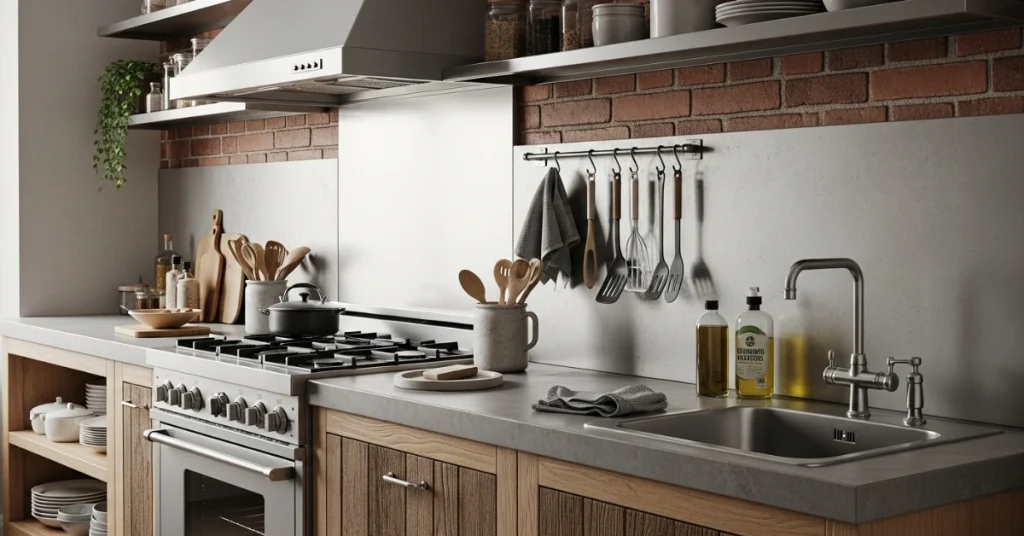
Industrial Kitchen Design on a Budget
You don’t need a big budget to achieve an industrial look. Here are cost-effective ideas:
- DIY Backsplash: Use peel-and-stick tiles that mimic brick or concrete.
- Secondhand Finds: Shop for reclaimed wood or vintage decor at thrift stores or salvage yards.
- Paint: A fresh coat of matte black or gray paint can transform cabinets or walls.
- Affordable Lighting: Look for budget-friendly Edison bulbs or metal pendant lights online.
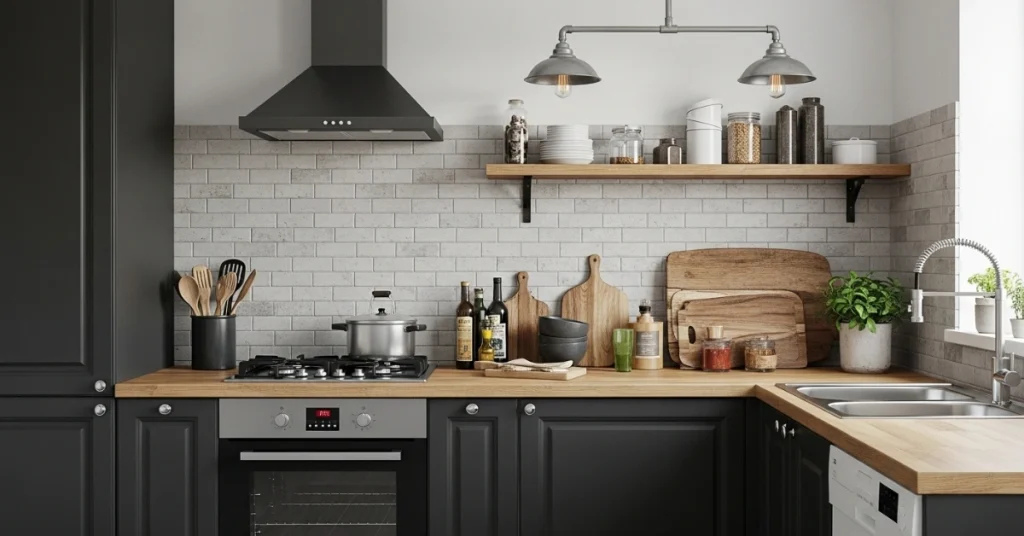
For example, a friend recently revamped their kitchen for under $2,000 by painting cabinets black, installing open wood shelves, and adding thrift-store bar stools. The result was a stunning industrial space on a tight budget.
Conclusion: Create Your Dream Industrial Kitchen
Industrial kitchen design offers a perfect blend of style, durability, and functionality. By embracing raw materials, neutral tones, and practical layouts, you can create a space that’s both timeless and tailored to your needs. Whether you’re drawn to the rugged charm of exposed brick or the sleek appeal of stainless steel, this style adapts to any home, budget, or lifestyle. Start by planning your layout, choosing durable materials, and adding personal touches to make the space uniquely yours.
Ready to transform your kitchen? Begin with small changes like open shelving or statement lighting, and let your creativity shine. For more inspiration or professional guidance, connect with a local interior designer or explore online resources to bring your industrial kitchen vision to life. What’s your first step? Share your ideas or start planning today!

